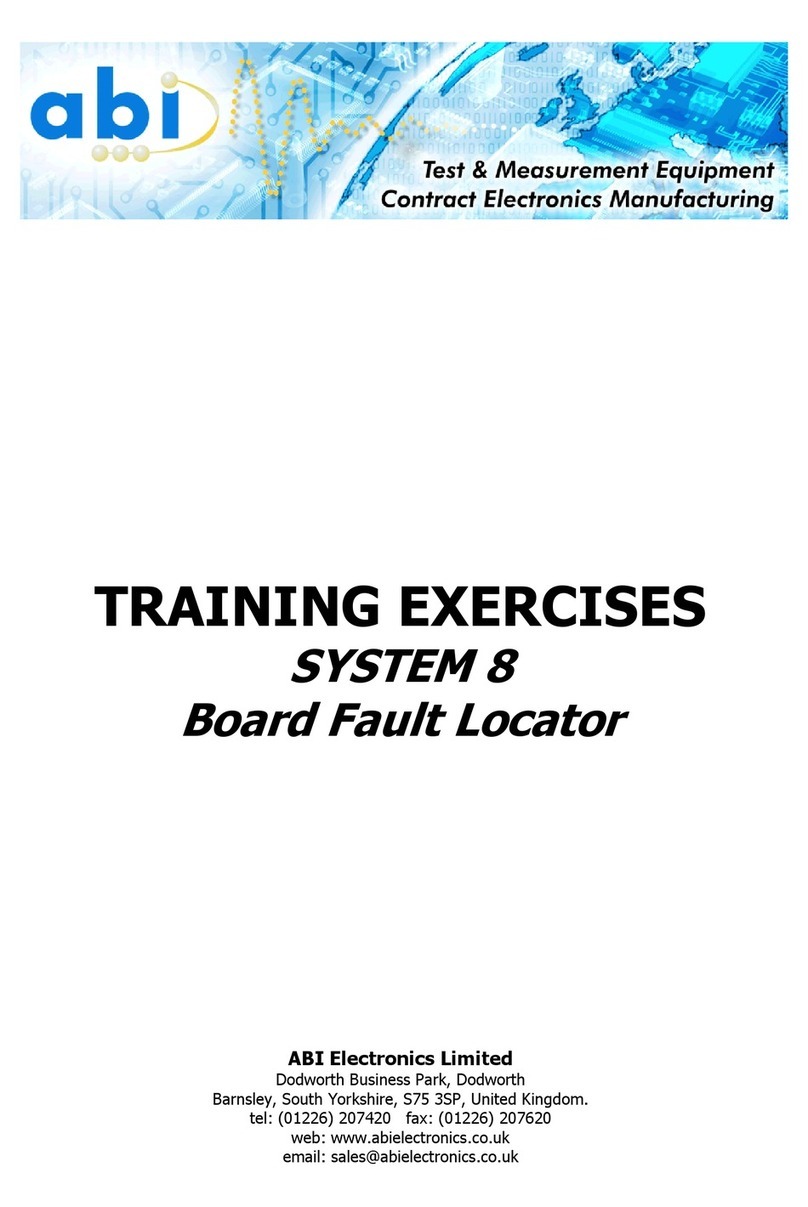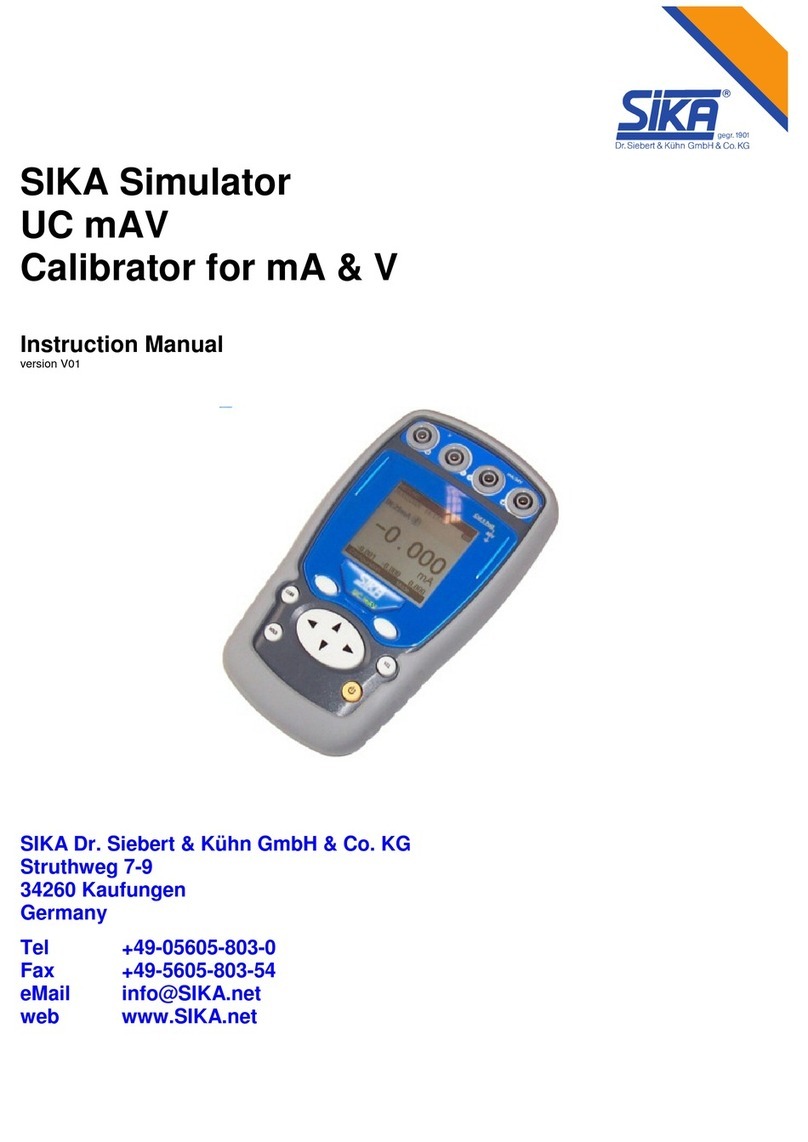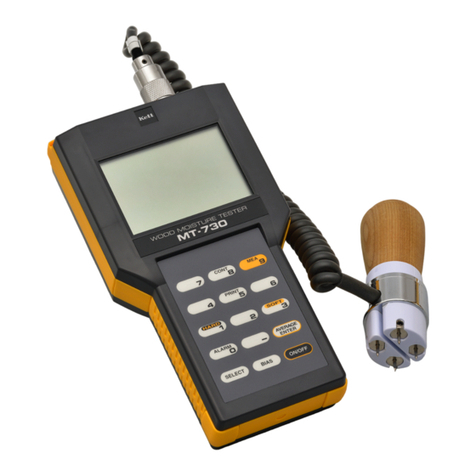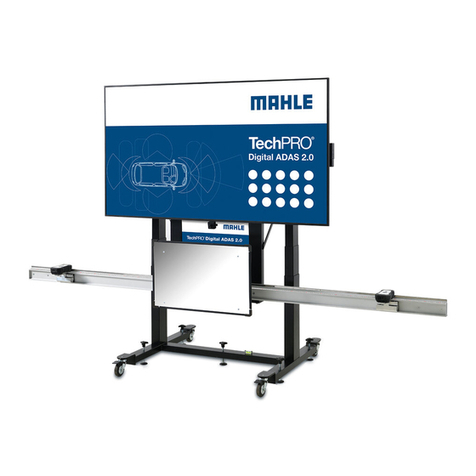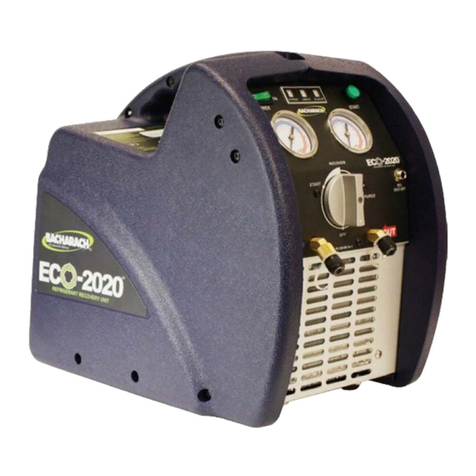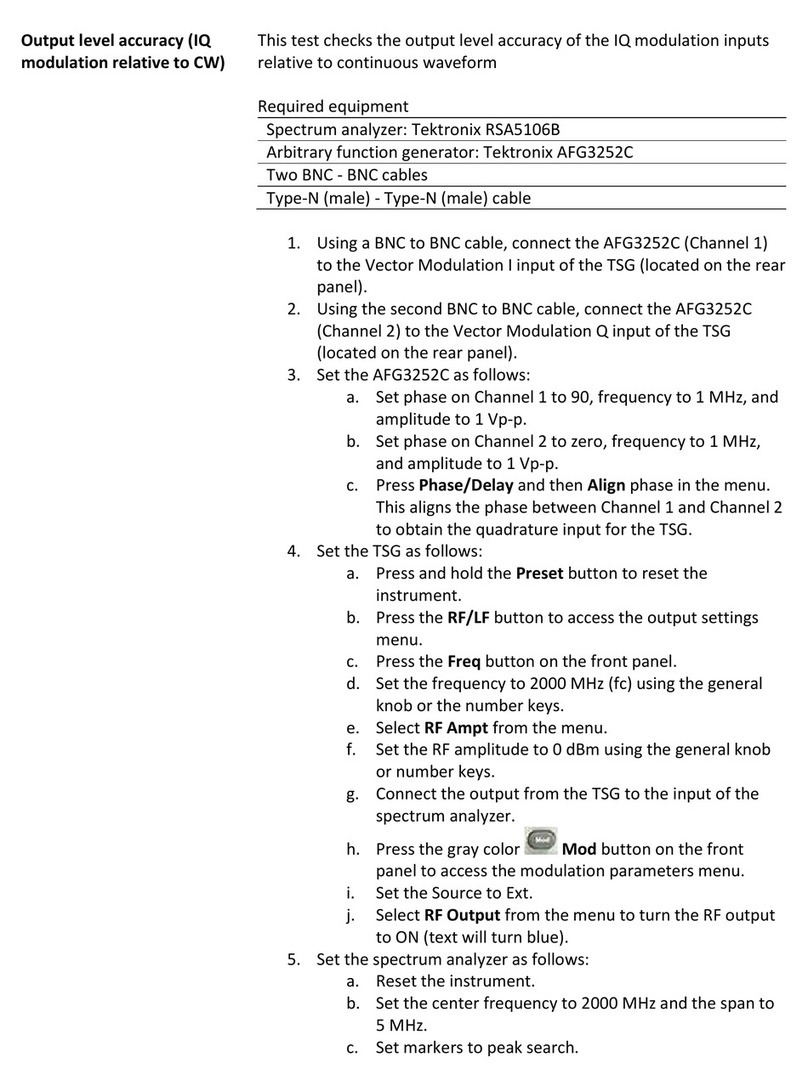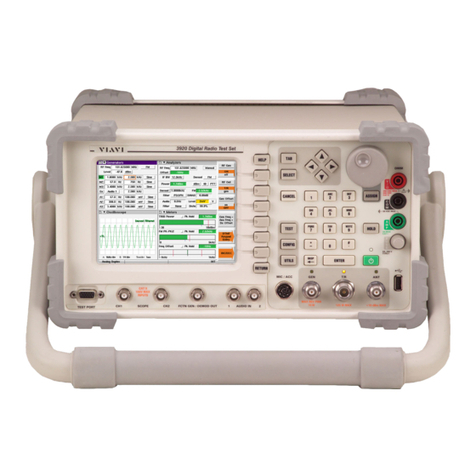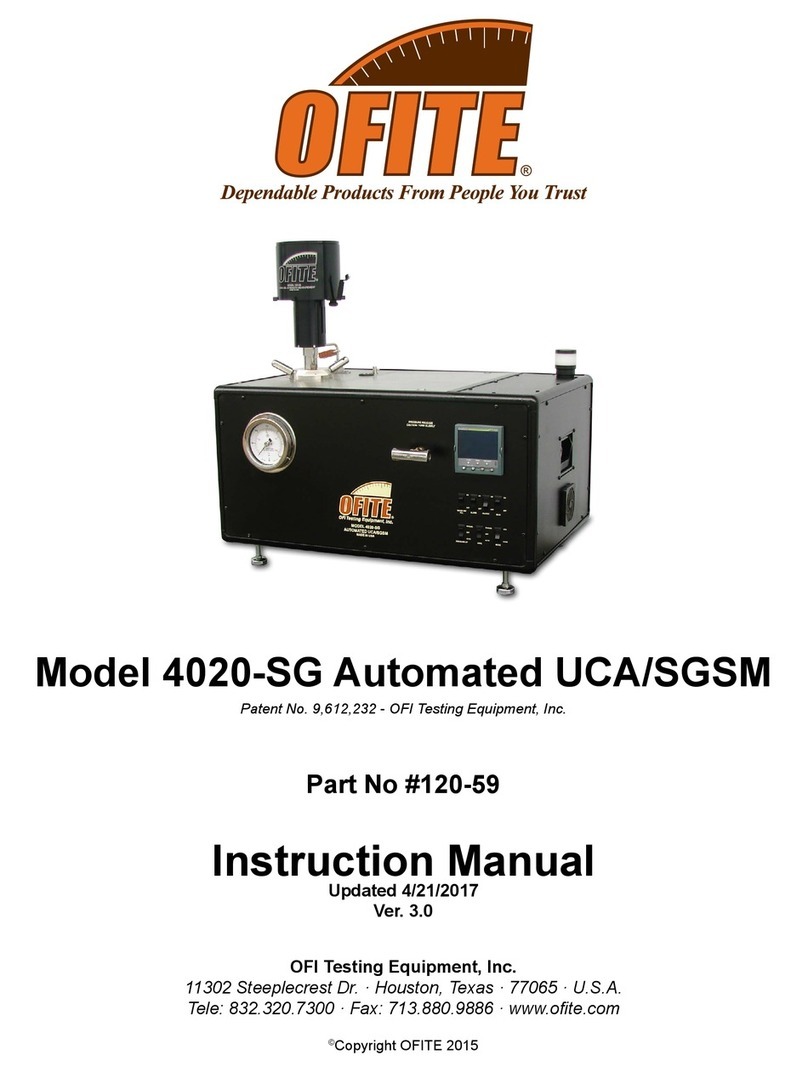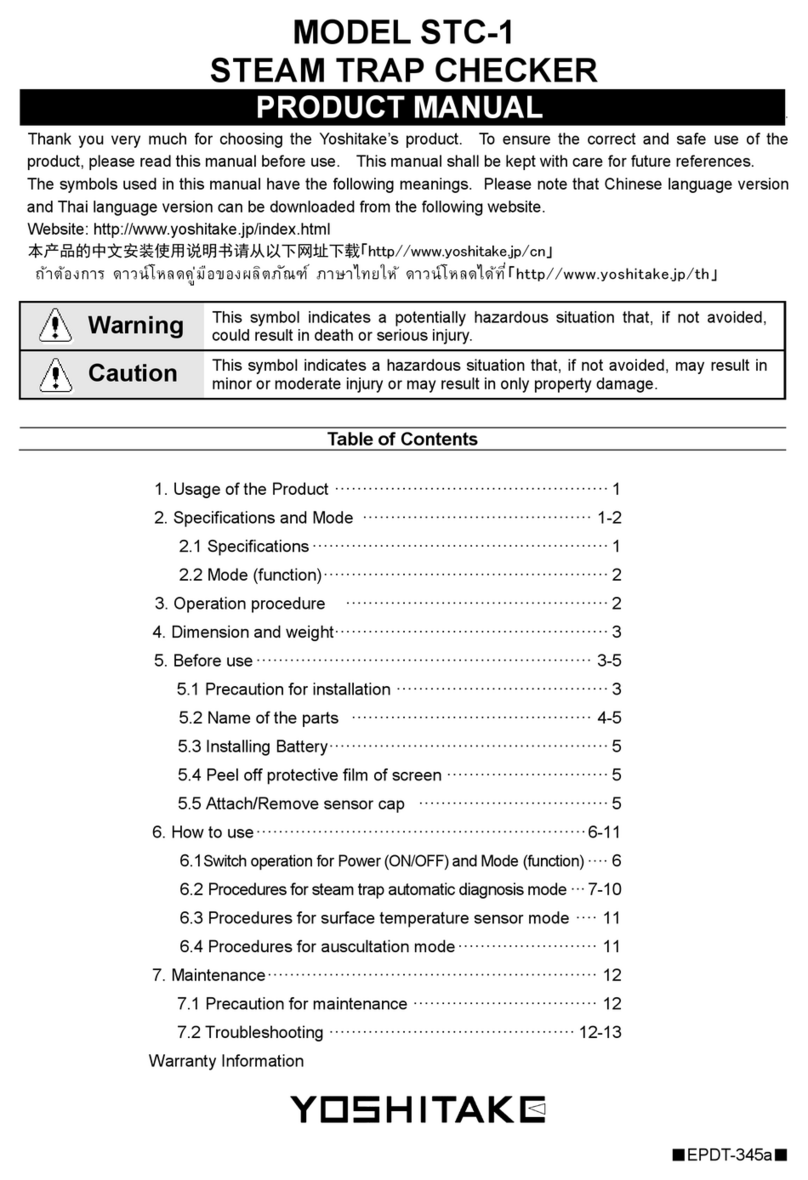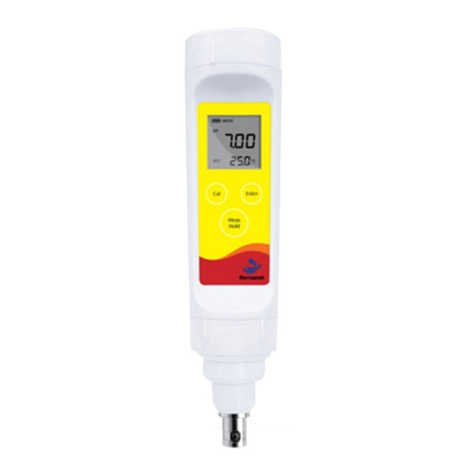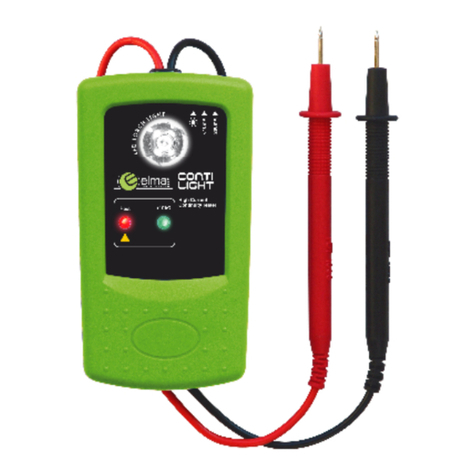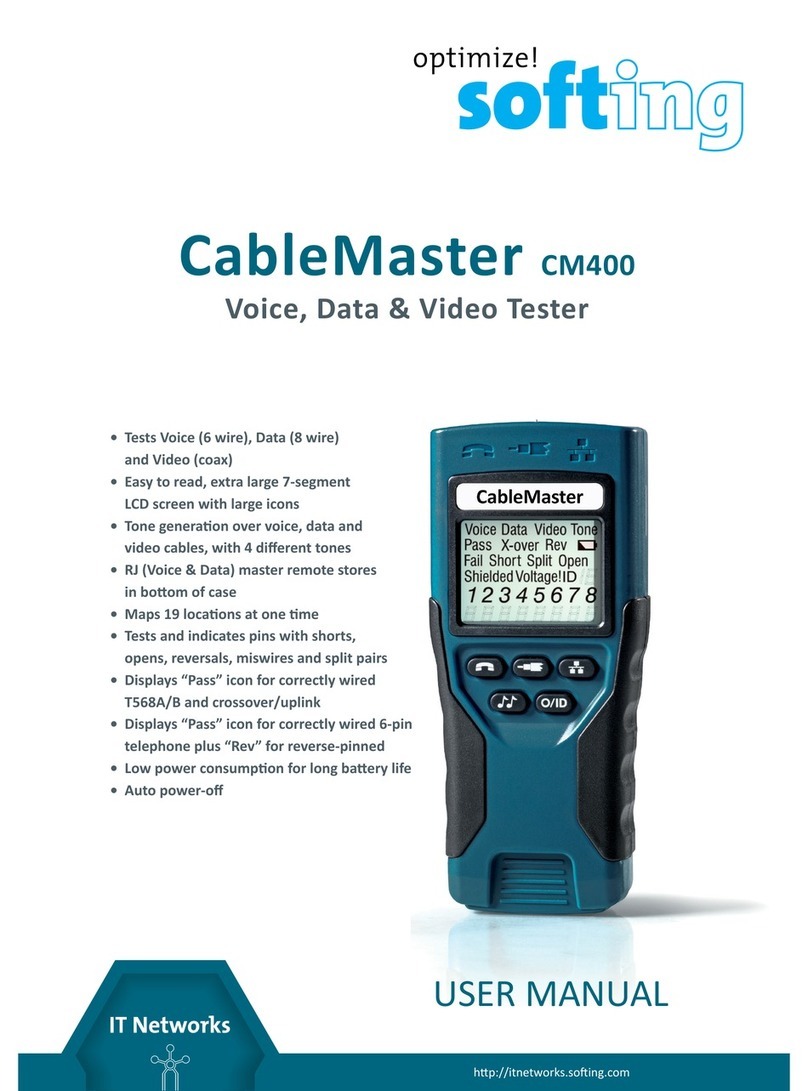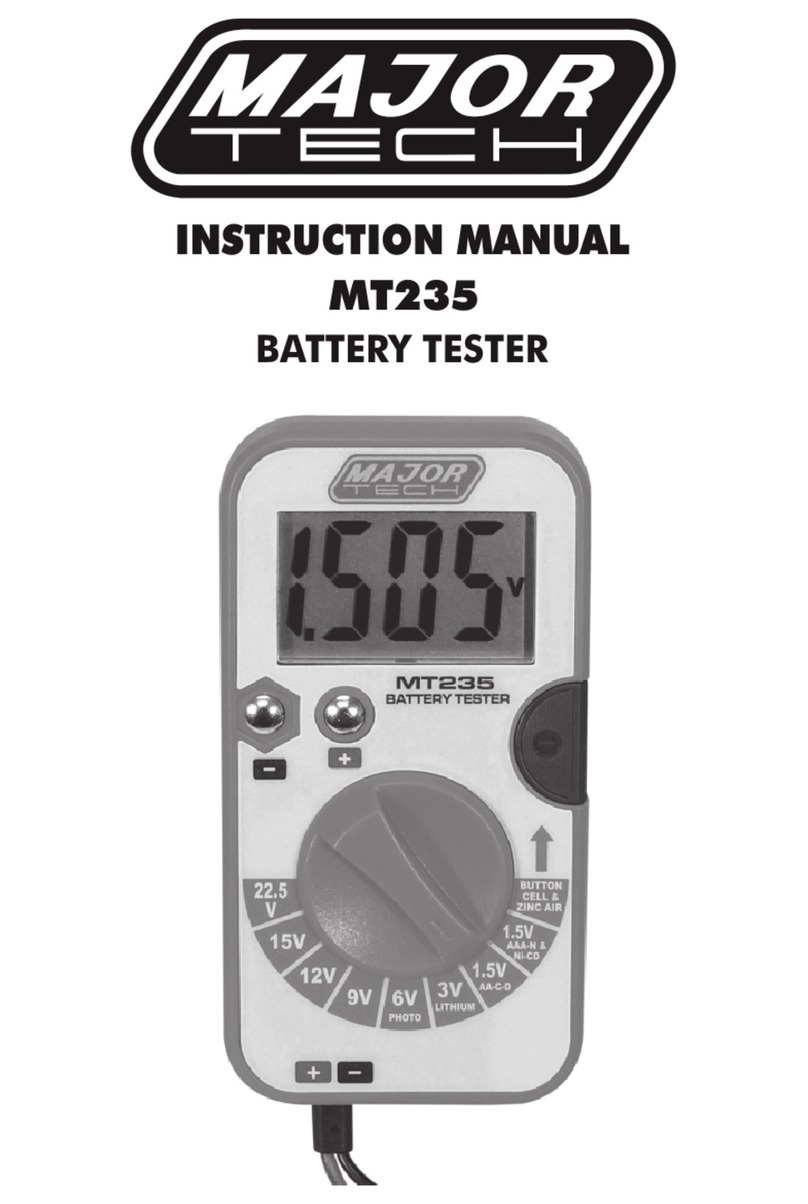abi Professional ChipMaster Compact User manual

ChipMaster Compact Digital IC Tester
Copyright 1992-2009 ABI Electronics Limited
CHIPMASTER COMPACT PROFESSIONAL
DIGITAL IC TESTER
OPERATOR’S MANUAL
CHIPMASTER COMPACT PROFESSIONELL
DIGITALER IC-TESTER
BEDIENUNGSANLEITUNG
CHIPMASTER COMPACT PROFESSIONNEL
TESTEUR DIGITALE DE CI
MANUEL D’UTILISATION

ChipMaster Compact Digital IC Tester
Copyright 1992-2009 ABI Electronics Limited
CONTENTS
1. introduction - english 1
2. DC input 1
3. battery eliminator 2
4. switching on 2
5. operating modes 3
6. entering test numbers 3
7. testing the IC 4
8. test results 4
9. testing further ICs 6
10. continuous testing 6
11. search mode 7
12. self test mode 7
13. CompactLink mode 8
14. specifications 9
15. Einführung - deutsch 10
16. Stromversorgung 10
17. Netzteil 11
18. Einschalten 11
19. Betriebsarten 12
20. Eingabe der IC-Nummern 12
21. Testen des ICs 13
22. Testergebnisse 13
23. Testen weiterer ICs 15
24. Fortlaufendes Testen 15

ChipMaster Compact Digital IC Tester
Copyright 1992-2009 ABI Electronics Limited
25. Suchmodus 16
26. Selbstdiagnosemodus 17
27. CompactLink-Modus 17
28. Spezifikation 18
29. introduction - français 19
30. alimentation continue (DC) 19
31. éliminateur de piles 20
32. mise sous tension 20
33. modes d’operation 21
34. introduction des numéros de CI 21
35. test d’un CI 22
36. résultats 22
37. test de plusieurs CI 24
38. test en continu 24
39. mode de recherche 25
40. mode test de démarrage 25
41. CompactLink mode 26
42. specifications 27
43. IC support list/ IC Liste/ Liste des CI soutenus 28
43.1. introduction/Einführung/introduction 28
43.2. series 54/74 TTL ICs 28
43.3. CMOS ICs 30
43.4. memory ICs 31
43.5. interface, peripheral, microprocessor and LSI ICs 32
43.6. notes on TTL ICs 34
43.7. notes on CMOS ICs 34
43.8. notes on memory ICs 35

ChipMaster Compact Digital IC Tester
Copyright 1992-2009 ABI Electronics Limited
43.9. notes on interface ICs 35
43.10. Anmerkungen für TTL ICs 36
43.11. Anmerkungen für CMOS ICs 36
43.12. Anmerkungen für Memory ICs 36
43.13. Anmerkungen für Interface ICs 37
43.14. notes sur CI TTL 37
43.15. Note sur CMOS CI 38
43.16. note sur memoire CI 38
43.17. notes sur interface CI 38

ChipMaster Compact Digital IC Tester
Copyright 1992-2009 ABI Electronics Limited
Page 1
1. introduction - english
Thank you for purchasing the ABI
ChipMaster Compact Professional
Digital IC Tester.
The basic function of the ChipMaster
Compact Professional is to test a
digital IC for correct logical functioning
as described in the truth table and/or
function table. The ChipMaster
Compact applies the necessary signals to the inputs of the IC,
monitoring the outputs at each stage and comparing them with the
expected states. Any discrepancy results in a FAIL indication and the
faulty pins are shown on the integral display. Additional facilities are also
provided, amongst them test loops that can be used for goods inwards
inspection, detecting intermittent faults or simply providing a rapid
method of exercising any IC for demonstration or educational purposes.
Since the ChipMaster Compact contains an extensive IC library, it is not
necessary to program the unit yourself other than to key in the IC
number. It is also capable of identifying an unknown IC using the
SEARCH mode - this is a feature that many users will find extremely
valuable.
The ChipMaster Compact Professional is provided with an RS-232
interface enabling it to be connected to a companion software package
called CompactLink running on a PC. CompactLink allows test
programmes for ICs not included in the internal library to be developed
and downloaded into the ChipMaster Compact memory to enhance the
library according to your wishes.
2. DC input
The ChipMaster Compact is powered by four AA batteries or by the use
of the battery eliminator input at the rear of the case. To insert the
batteries, turn the unit upside down and remove the battery cover by
removing the two cross head screws holding it in place. The batteries
must be inserted in the correct orientation, as indicated by the drawing
within the battery compartment. Incorrect insertion of batteries will not
allow the unit to operate. Replace the battery cover and insert the
screws. If the battery voltage falls too low, a low battery warning symbol
will be displayed at the top left hand cell of the display in normal

ChipMaster Compact Digital IC Tester
Copyright 1992-2009 ABI Electronics Limited
Page 2
operating mode. A low battery warning will also be displayed during a
result display. Test results may be inconsistent under these conditions.
3. battery eliminator
An external battery eliminator is available for prolonged use of the
ChipMaster Compact. Many bipolar LSI ICs consume a large amount of
current when powered up, and battery life can be conserved by using the
eliminator. There is no need to remove the batteries prior to inserting
the battery eliminator. However, please note that during prolonged
periods of non-use batteries are prone to leakage and should be
removed. Note that to avoid damage to the unit we strongly advise that
you only use the recommended battery eliminator that is available by
contacting your distributor. Note that using an incorrect battery
eliminator voltage may damage the unit and invalidate the warranty.
4. switching on
To switch the unit on, simply press the 'ON' key. To preserve battery
life, the unit powers itself off after approximately 3 minutes of non-use or
when “Sw Off” is selected from the main menu. When the unit is
switched on, it first performs a self-diagnosis test. Therefore, before
switching on, check that the test socket is empty to prevent interference
with the diagnostics. If the unit passes the self-test, a pass result will be
displayed on the screen. Press a key to enter the main operating mode
- the display will be as follows:
When this initial display is obtained the ChipMaster Compact is ready for
use. If, however, the message SELF-TEST FAIL: is displayed along
with a fault message, this indicates that a self-test diagnostic fault has
been detected. Any detected faults will be displayed one at a time.
Pressing the TEST/EXEC key will then revert to the opening menu as
above, but of course operation of the unit will then be suspect. Before
contacting your distributor, check that the test socket is completely
empty.
NO:
MODE:Single:RDY

ChipMaster Compact Digital IC Tester
Copyright 1992-2009 ABI Electronics Limited
Page 3
5. operating modes
The ChipMaster Compact has a number of test modes that are selected
using the MODE/CLEAR key from the initial screen. The test modes are
as follows:
Single - execute a single test on the IC in the socket.
Loop - execute test repeatedly, regardless of the result.
P Loop - execute test repeatedly, provided the result was PASS.
F Loop - execute test repeatedly, provided the result was FAIL.
Search - identify the number of the IC in the socket.
Diags - execute the diagnostic self-test.
CmLink - enter remote mode for CompactLink software.
Sw Off - turn off the unit.
6. entering test numbers
Press the MODE/CLEAR key until the desired test mode is displayed.
Enter the number of the IC you wish to test. Pressing the
MODE/CLEAR key will clear the last digit from the display if a mistake is
made.
Note: The NUMERIC information only is entered, leaving out the
manufacturers prefixes and suffixes and IC family information. As
an example, all the following TTL ICs should be entered as 7, 4, 0, 0
on the keypad:
e.g. DM74LS00J, N74LS00N, N74S00N, N7400N, 74ALS00N,
SN74HCT00
A very small number of ICs have differing pin-outs for different IC
families - in these cases, the most popular pin-out only is supported.
The CMOS 4000 series is also supported and the IC numbers for this
family should all begin with "4", so that with for example Motorola ICs
beginning MC14... the initial "1" should be omitted. The same principles
apply also to memory ICs, which are mostly four digit numbers. With
interface ICs of the 8T series the "T" should be omitted. A complete list
of all ICs supported by the ChipMaster Compact is contained in the IC
SUPPORT LIST at the end of this manual together with notes on any
special requirements for certain ICs.
Note that if you have stored a user library using CompactLink, an IC in
the user library with the same number as one in the internal library will
take precedence. This allows a new test to be written for an existing IC.

ChipMaster Compact Digital IC Tester
Copyright 1992-2009 ABI Electronics Limited
Page 4
If you wish both tests to be available, use a different number for your
user test.
7. testing the IC
Insert the IC to be tested in the front of the 40 pin Zero Insertion Force
socket with pin 1 towards the display as shown below:
Ensure that the operating lever on the socket is in the open (i.e. up)
position before inserting the IC. Close the socket by lowering the lever,
making sure that the IC is firmly seated in the socket and making good
contact. Press the TEST/EXEC key to activate the test sequence for the
IC. If an invalid IC type number was entered, or if the IC you have
requested is not supported the message "Unknown" will be displayed.
Simply entering another IC type number will automatically clear this error
message. If a valid type number was entered, the IC test will begin and
the message "BUSY" will be displayed while the test proceeds. Many of
the tests, however, execute so quickly that this message is not
noticeable.
8. test results
A pre-determined sequence of signals is applied to the inputs of the IC
and the IC outputs are monitored for the correct logic levels. The unit
uses TTL or CMOS logic thresholds (depending on the selected IC)
when evaluating the response of the IC outputs. If all the outputs
respond correctly, the result PASS will be displayed at the top right of the
display. A scrolling message will contain the IC function and power pin
information.
If a short circuit between the power pins of the IC is detected, a warning
‘SHT!' will appear on the top right of the display and, since no valid test

ChipMaster Compact Digital IC Tester
Copyright 1992-2009 ABI Electronics Limited
Page 5
is then possible, the result will FAIL. If the IC under test takes an
excessive amount of current when power is applied, a warning 'ICC!' will
appear. Press the TEST/EXEC key to continue with the test, or
MODE/CLEAR to abandon. Depending on the condition of the batteries
there may also be a ‘BAT!’ warning which indicates that the batteries are
incapable of supplying the current required by the IC under test. You
can continue with the test by pressing the TEST/EXEC key, but the unit
may malfunction because of a drop in battery voltage. To avoid this,
change the batteries or use a battery eliminator. Note that a faulty IC
may demand more operating current and therefore will quickly drain the
batteries.
In the case of a FAIL result, the error conditions at all the non-functional
pins of the IC will be scrolled on the display, and the IC function will be
shown. The various failure conditions that can be displayed are as
follows:
LOW - the output was LOW when HIGH was expected.
MID LOW - the output was LOW, but not a valid logic level.
HIGH - the output was HIGH when LOW was expected.
MID HIGH - the output was HIGH, but not a valid logic level.
LOAD 0V - the input cannot be driven HIGH.
LOAD 5V - the input cannot be driven LOW.
In some cases, the scrolling test results may include one or more
WARNING indications. These warnings indicate conditions that may
result in an incorrect test result, and are as follows:
D/F - result may be invalid because last self-test failed.
BAT - battery voltage too low during test.
ICC - large current taken by IC under test.
The scrolling message can be cancelled by pressing the MODE/CLEAR
key, or paused by pressing and holding a numeric key. If you want to
test the IC again, press the TEST/EXEC to abandon the scroll and
perform another test.
Before discarding a failed IC check that the correct IC type number was
entered and also check that the IC pins are clean and making good
contact with the test socket. Note that there is no way of stopping a test
once it has commenced, but see the description of loop functions later in
this manual.

ChipMaster Compact Digital IC Tester
Copyright 1992-2009 ABI Electronics Limited
Page 6
9. testing further ICs
After a test is completed, the test result will be displayed. To test
another IC of the same type, simply insert the next IC and press the
TEST/EXEC key again. To test a different IC, enter the new IC type
number in the usual way, noticing that pressing the first digit of the new
number automatically clears the previous number from the display.
Remember that the MODE/CLEAR key can be used if an error is made
during the entry of the IC type number.
10. continuous testing
It is possible to test the same IC repeatedly to detect intermittent or
temperature-related faults, or to rapidly test a batch of identical ICs.
There are three types of test loop modes:
Loop - execute a test repeatedly, regardless of the result.
P Loop - execute a test repeatedly, provided the result is PASS.
F Loop - execute a test repeatedly, provided the result was FAIL.
The ChipMaster Compact is configured into one of the loop modes using
the MODE/CLEAR key as described earlier. Insert the IC and press
TEST/EXEC in the usual way to start the continuous test process. The
result of each test is displayed as PASS or FAIL on the top right of the
display. In LOOP mode, this allows a large batch of identical ICs to be
tested, without any action on the part of the operator other than inserting
the IC. When the IC is inserted, sufficient time must be allowed for the
test to take place before the result status is updated, so if in doubt the IC
should be tested in single mode so that the approximate test time can be
determined. It will be found that high throughput can be obtained using
this mode.
To stop any of the test loops, press MODE/CLEAR, but note that the test
in progress is completed before the command is obeyed. The effect of
this is usually unnoticeable, but where the test takes a reasonable time
to execute there will be a delay before the instrument responds to the
MODE/CLEAR key.
Note: Testing high current ICs in loop mode will drain the batteries
quickly, and it is recommended that a battery eliminator is used if
you wish to perform loop tests.

ChipMaster Compact Digital IC Tester
Copyright 1992-2009 ABI Electronics Limited
Page 7
11. search mode
This feature allows the type number of an unknown IC to be determined,
provided the IC is actually contained in the ChipMaster Compact library,
and it is a correctly functioning IC. This facility is useful when the IC type
number is illegible or has been removed.
Use the MODE/CLEAR key to choose SEARCH mode, insert the
unknown IC into the socket and press the TEST/EXEC key. You will be
prompted to choose the number of pins of the IC you wish to identify -
use the MODE/CLEAR key to select from 8 to 40 pins or 'QUIT' to
abandon this mode. Press the TEST/EXEC key again to start the
SEARCH or to quit as required.
During the identification process the display will indicate the number of
ICs identified (IDENT:) and will show graphically how far through the
library the SEARCH has progressed. At the end of the SEARCH, a list
of all the similar ICs will be scrolled onto the display. The list may be
scrolled again by pressing the TEST/EXEC key. The scrolling message
can be cancelled by pressing the MODE/CLEAR key, or paused by
pressing and holding a numeric key.
If the IC cannot be identified the message "Not in Library" will be
displayed. This means either that the IC is not in the library or it is non-
functional. Note that if the Compact detects excessive supply current
(ICC! or BAT! warnings), the IC will not be identified during the
SEARCH, but can still be tested in SINGLE mode.
If you have a user library present the search will extend to user ICs in
that library also. However, CompactLink contains a facility for excluding
ICs from the search if required.
12. self test mode
This feature allows you to check the integrity of the unit, including the pin
drivers and receivers, power supplies and other internal hardware. The
test executes automatically at switch on, but you can if you wish perform
a self-test at any time by selecting Self-Test (DIAGS) mode using the
MODE/CLEAR key and pressing TEST/EXEC.
If a fault is discovered a brief description will be displayed which will help
our engineers to locate and rectify the fault. This message should be
noted and quoted in any correspondence relating to a unit fault. Contact

ChipMaster Compact Digital IC Tester
Copyright 1992-2009 ABI Electronics Limited
Page 8
your distributor in the event of a self-test fail, but first of all ensure that
the socket was empty when the diagnostics were run.
13. CompactLink mode
The ChipMaster Compact Professional is provided with an RS-232
interface to connect to a PC with a serial COM port or using a USB to
RS-232 converter. A companion software package CompactLink is
available which provides library management, test development and
debugging and user library update facilities. You can also use
CompactLink to update the software of your ChipMaster Compact
without replacing the internal memory or opening the case.
To enter CompactLink mode, user the MODE/CLEAR key to enter
CMLINK mode, then press TEST/EXEC. Press TEST/EXEC again to
confirm that you wish to enter CompactLink mode, and the display will
show “Not Connected”. Run the CompactLink software on your PC,
connect the serial cable and follow the CompactLink manual instructions
to connect to the ChipMaster Compact Professional.
For comprehensive instructions on using CompactLink please refer to
the manual and built-in help supplied with the software.
Note that in CompactLink mode, including waiting for a connection, the
normal power down timeout is disabled and the unit will remain on for
ever. We recommend using a battery eliminator when using
CompactLink mode to develop test programmes.

ChipMaster Compact Digital IC Tester
Copyright 1992-2009 ABI Electronics Limited
Page 9
14. specifications
SPECIFICATIONS
Batteries 4 X AA size
DC input 6V, 850mA max, centre positive, regulated
Power consumption
Power off 10µA max
Standby 30mA
Testing IC dependent
Test thresholds (internal library) TTL low 0.5V max
TTL switching 1.2V
TTL high 2.4V min
CMOS low 0.5V max
CMOS switching 2.4V
CMOS high 3.8V min
Test thresholds (user library) Programmable 0V to 5V (using CompactLink)
RS-232 settings 38400 baud, 8 data bits, 1 stop bit, no parity
Dimensions 200mm X 100mm X 55mm approx.
Library ICs TTL, CMOS, VLSI, Interface, Memory, User

ChipMaster Compact Digital IC Tester
Copyright 1992-2009 ABI Electronics Limited
Page 10
15. Einführung - deutsch
Vielen Dank, dass Sie sich für den Kauf
eines ABI ChipMaster Compact
Professionell Digital IC Testers
entschieden haben.
Die Hauptfunktion des ChipMaster
Compact Professionell besteht darin, ein
digitales IC laut seiner Wahrheits- bzw.
Funktionstabelle auf sein korrektes
Funktionieren zu testen. Der ChipMaster Compact generiert die
notwendigen Eingangsignale für das IC, und vergleicht dann die
Ausgangsignale mit den zu erwartenden Signalen. Aus jeglicher
Diskrepanz resultiert eine Fehlermeldung und die fehlerhaften Pins
werden auf dem integrierten LCD Display angezeigt. Weitere
Fähigkeiten des Gerätes bestehen u.a. in Test-Schleifen, um IC-
Inspektion oder das Suchen von intermittierenden Fehlern zu
vereinfachen. Da der ChipMaster Compact über ein reichhaltiges IC-
Verzeichnis verfügt, ist eine Programmierung des Gerätes nicht
erforderlich. Er ist außerdem in der Lage, unbekannte ICs mit Hilfe des
Suchmodus zu erkennen – diese Funktion werden viele Benutzer als
extrem nützlich empfinden.
Der ChipMaster Compact Professionell verfügt über eine RS232-
Schnittstelle, damit das Gerät mit der PC-basierten
Software CompactLink verbunden werden kann. Damit können Sie
Testprogramme für unbekannte ICs entwickeln und zu dem ChipMaster
Compact herunterladen, um die Bibliothek umzurüsten.
16. Stromversorgung
Der ChipMaster Compact wird mit vier AA-Batterien oder unter
Verwendung eines im hinteren Teil des Gehäuses angeschlossenen
Netzteils betrieben. Zum Einlegen der Batterien entfernen Sie die
Batterieklappe auf der Unterseite des Gerätes, indem Sie die beiden
Kreuzschlitzschrauben lösen. Die Batterien müssen richtig herum
eingesetzt werden, wie auf der Abbildung gezeigt, die sich in dem
Batteriefach befindet. Falsch eingesetzte Batterien lassen das Gerät
nicht funktionieren. Setzen Sie nun die Batterieklappe wieder auf und
verschrauben Sie diese. Sobald die Spannung der Batterien zu niedrig
fällt, erscheint in normalem Betriebszustand ein Warnsymbol oben links

ChipMaster Compact Digital IC Tester
Copyright 1992-2009 ABI Electronics Limited
Page 11
im Display. Auch während Testergebnisse auf dem Display erscheinen,
leuchtet das Warnsymbol auf. Unter diesen Umständen kann es zu
unstimmigen Ergebnissen kommen.
17. Netzteil
Für einen längeren Gebrauch des ChipMaster Compact ist ein externes
Netzteil erhältlich. Viele bipolaren ICs verbrauchen verhältnismäßig viel
Strom wenn sie eingeschaltet werden, und die Haltbarkeit der Batterien
kann durch den Gebrauch eines Netzteils verlängert werden. Es ist
nicht nötig, die Batterien vor dem Einsetzen des Netzteils zu entfernen.
Doch beachten Sie bitte, dass nach längerer Nicht-Benutzung die
Batterien dazu neigen, auszulaufen und daher rechtzeitig entfernt
werden sollten. Um Schäden an dem Gerät zu vermeiden raten wir
Ihnen dringend, nur das von uns empfohlene Netzteil zu benutzen, das
Sie über Ihren Vertreter erwerben können. Beachten Sie bitte, dass
eine falsche Ausgangsspannung des Netzteils das Gerät beschädigen
kann und die Garantie nicht gewährleistet werden kann.
18. Einschalten
Um das Gerät einzuschalten, drücken Sie einfach die ON-Taste. Wird
das eingeschaltete Gerät etwa 3 Minuten nicht benutzt oder „Sw Off“
vom Hauptmenü ausgewählt, schaltet es sich selbständig ab, um das
Leben der Batterien zu verlängern. Wird das Gerät eingeschaltet, so
führt es zunächst eine Selbstdiagnose durch. Daher prüfen Sie vor dem
Einschalten, ob der Testsockel leer ist, um Störungen der Diagnose zu
vermeiden. Besteht das Gerät die Selbstdiagnose, erscheint folgende
Anzeige: -
Wenn diese erste Anzeige erscheint, ist der ChipMaster Compact zur
Benutzung bereit. Sollte allerdings die Nachricht „SELF-TEST FAIL:”
zusammen mit einer Fehlermeldung erscheinen, so bedeutet dies, dass
ein Selbstdiagnose-Fehler entdeckt wurde. Alle gefundenen Fehler
werden kürz angezeigt, bevor zu dem oben gezeigten Menü
zurückgekehrt wird, doch natürlich wird dann die Qualität weiterer Tests
NO:
MODE:Single:RDY

ChipMaster Compact Digital IC Tester
Copyright 1992-2009 ABI Electronics Limited
Page 12
zweifelhaft sein. Bevor Sie sich an ihren Vertreter wenden, stellen Sie
sicher, dass der Testsockel komplett leer ist.
19. Betriebsarten
Der ChipMaster Compact verfügt über verschiedene Testarten,
zwischen denen man innerhalb des Startmenüs mittels der
MODE/CLEAR-Taste wählen kann. Es gibt folgende Testarten: -
Single - führt einen einzelnen Test des ICs durch.
Loop - wiederholter Test unabhängig von dem Ergebnis.
P Loop - wiederholter Test solange das Ergebnis gut ist.
F Loop - wiederholter Test solange das Ergebnis schlecht ist.
Search - identifiziert die Nummer des ICs.
Diags - führt die Selbstdiagnose durch.
CmLink - Ferngesteuerter Modus für CompactLink-Software.
Sw Off - Gerät auschalten.
20. Eingabe der IC-Nummern
Drücken Sie die MODE/CLEAR-Taste bis die gewünschte Testart
angezeigt wird. Geben Sie nun die Nummer des zu testenden ICs ein.
Sollten Sie einen Fehler bei der Eingabe machen, wird die Anzeige
durch Drücken der MODE/CLEAR-Taste gelöscht und Sie können die
Eingabe wiederholen.
Bitte beachten Sie: Es wird nur die numerische Information
eingegeben, alle Angaben zum Hersteller oder zur IC-Familie
werden nicht berücksichtigt. So sollten zum Beispiel alle
folgenden TTL-ICs als 7,4,0,0 auf der Tastatur eingegeben werden:
-
z.B. DM74LS00J, N74LS00N, N74S00N, N7400N, 74ALS00N,
SN74HCT00
Einige wenige ICs haben Familienabhängige Pinkonfigurationen – in
solchen Fällen wird nur die häufigste Pinkonfiguration unterstüzt. Die
CMOS-4000 Familie wird auch unterstüzt, und die IC-Nummern dieser
Familie fangen alle mit „4” an. So sollten Sie das erste „1” für Motorola
CMOS ICs (die mit „MC14…” anfangen) weglassen. Ebenfalls muss
das „T” von Interface-ICs der „8T” Familie weggelassen werden.
Eine komplette Liste von den unterstüzten ICs (wenn notwendig mit
Anmerkungen) wird am Ende dieser Anleitung angezeigt.

ChipMaster Compact Digital IC Tester
Copyright 1992-2009 ABI Electronics Limited
Page 13
Wenn Sie eine Benutzer-IC-Bibliothek installiert haben, bitte merken Sie
sich, dass ein Benutzer-IC mit der identischen Nummer zu einem IC in
der eingebauten Bibilothek bevorzugt wird. Dies erlaubt, dass ein neuer
Test für ein existierendes IC geschrieben werden kann. Wenn Sie beide
Tests benutzen wollen, benutzen Sie eine andere Nummer für Ihren
Benutzer-IC-Test.
21. Testen des ICs
Setzen Sie das zu testende IC in den vorderen Teil des Sockels, mit Pin
1 zu dem LCD-Display wie im unteren Diagramm dargestellt: -
Bevor Sie das IC einlegen stellen Sie sicher, dass sich der
Betriebshebel in der geöffneten Position (d.h. oben) befindet. Schließen
Sie den Sockel, indem Sie den Hebel nach unten drücken. Prüfen Sie
vorher noch, dass das IC fest auf dem Sockel sitzt und guten Kontakt
hat. Drücken Sie die TEST/EXEC-Taste um die Testsequenz für das IC
zu aktivieren. Wenn eine falsche IC-Nummer eingegeben wurde, oder
wenn das von Ihnen gewünschte IC nicht unterstützt wird, erscheint die
Nachricht „Unknown" auf dem Display. Die Eingabe einer anderen IC-
Nummer wird diese Anzeige automatisch löschen. Wurde eine gültige
Nummer eingegeben, beginnt der Test und die Nachricht „BUSY" wird
angezeigt während der Test läuft. Allerdings laufen viele Tests so
schnell ab, das diese Nachricht nicht erkennbar wird.
22. Testergebnisse
Eine vorbestimmte Folge von Signalen wird an den Eingängen des ICs
angewendet und die Ausgänge werden auf den richtigen Logikpegeln
überwacht. Das Gerät benutzt TTL-Logikpegel während es die
Reaktionen der IC-Ausgänge auswertet. Reagieren alle Ausgänge

ChipMaster Compact Digital IC Tester
Copyright 1992-2009 ABI Electronics Limited
Page 14
korrekt, wird oben rechts auf dem Display das Ergebnis PASS
angezeigt. Eine rollende Nachricht enthält sowohl die IC-Funktion als
auch die Versorgungspin-Information.
Wird ein Kurzschluss zwischen den Stromversorgungspins des getesten
ICs entdeckt, erscheint oben rechts auf dem Display die Warnung
„SHT!” und das Ergebnis wird FAIL (schlecht), weil kein gültiger Test
möglich ist. Wenn das getestete IC beim Stromeinschalten einen
übermäßigen Stromverbrauch hat, erscheint oben rechts auf dem
Display die Warnung „ICC!”. Drücken Sie die TEST/EXEC-Taste, um
mit dem Test fortzufahren, oder die CLEAR-Taste, um den Vorgang
abzubrechen. Abhängig vom Zustand der Batterien kann auch die
Warnung „BAT!” erscheinen. Dies bedeutet, dass die Batterien nicht in
der Lage sind, die von dem getesteten IC benötigte Energie zu liefern.
Durch drücken der TEST/EXEC-Taste können Sie mit dem Test
fortfahren, doch es könnte zu Funktionsstörungen des Gerätes aufgrund
von zu geringer Batteriespannung kommen. Wechseln Sie die Batterien
oder benutzen Sie ein externes Netzteil. Beachten Sie, dass ein
fehlerhafter IC mehr Strom verbrauchen kann und dadurch schnell die
Batterien verbraucht.
Im Falle des Ergebnisses „FAIL”, werden die Logikfehler an allen nicht
funktionierenden Pins des ICs auf dem Display gerollt, und die IC-
Funktion wird angezeigt. Die verschiedenen Logikfehler werden wie
folgt angezeigt:
LOW - Ausgang LOW obwohl HIGH erwartet wurde.
MID LOW - Ausgang LOW, aber ungültiger Logik-Pegel entdeckt.
HIGH - Ausgang HIGH obwohl LOW erwartet wurde.
MID HIGH - Ausgang HIGH aber ungültiger Logik-Pegel entdeckt.
LOAD 0V - Eingang wurde nicht mit gültigem HIGH getrieben.
LOAD 5V - Eingang wurde nicht mit gültigem LOW getrieben.
In manchen Fällen können die rollenden Testergebnisse eine oder
mehrere Warnmeldungen enthalten. Diese Warnungen weisen auf
Bedingungen hin, die ein falsches Testergebnis zur Folge haben
könnten: -

ChipMaster Compact Digital IC Tester
Copyright 1992-2009 ABI Electronics Limited
Page 15
D/F - das Ergebnis kann ungültig sein, da die letzte
Selbstdiagnose fehlgeschlagen ist.
BAT! - die Batteriespannung war während des Tests zu niedrig.
ICC! - das getestete IC hatte einen hohen Stromverbrauch
Bevor Sie einen fehlerhaften IC aussortieren überprüfen Sie, ob die
korrekte IC-Nummer eingegeben wurde und ob die Pins des ICs alle
sauber sind und fest im Testsockel sitzen. Beachten Sie, dass ein
begonnener Test nicht abgebrochen werden kann (sehen Sie aber die
Schleiftestfunktionen).
23. Testen weiterer ICs
Nachdem ein Test beendet ist, wird das Ergebnis angezeigt. Um ein
anderes IC desselben Typs zu testen, legen Sie dies einfach ein und
drücken Sie wieder die TEST/EXEC-Taste. Um ein unterschiedliches IC
zu testen, geben Sie auf dem üblichen Wege die neue IC-Nummer ein.
Beachten Sie, dass die Eingabe der ersten Ziffer der neuen Nummer die
vorige Nummer automatisch von der Anzeige löscht. Wieder kann die
MODE/CLEAR-Taste benutzt werden, falls es zu einem Fehler während
der Eingabe kommt.
24. Fortlaufendes Testen
Es ist möglich, das gleiche IC wiederholt zu testen, um es auf
intermittierende oder temperaturabhängige Fehler zu testen, oder um
eine größere Menge identischer ICs in sehr kurzer Zeit zu testen. Es
gibt drei Arten dieser Testschleifen: -
Loop - wiederholt einen Test unabhängig von dem Ergebnis
immer wieder durch.
P Loop - wiederholt einen Test immer wieder, solange das
Ergebnis PASS (gut) lautet.
F Loop - wiederholt einen Test immer wieder, solange das
Ergebnis FAIL (schlecht) lautet.
Der ChipMaster Compact wird wie oben beschrieben mit der
MODE/CLEAR-Taste auf einen der LOOP-Modi eingestellt. Legen Sie
das IC ein und drücken Sie die TEST/EXEC-Taste, um das fortlaufende
Testverfahren zu starten. Das Ergebnis jedes Tests wird als „PASS”
oder „FAIL” oben rechts auf dem Display angezeigt. Im LOOP-Modus
ermöglicht dies den Test einer großen Anzahl identischer ICs, ohne

ChipMaster Compact Digital IC Tester
Copyright 1992-2009 ABI Electronics Limited
Page 16
dass der Benutzer etwas anderes tun muss als die ICs einzulegen.
Nachdem das IC eingelegt wird, besteht eine IC-abhängige
Verzögerung, bis das Display aktualisiert wird. Im Zweifel kann der Test
einmal im SINGLE-Modus durchgeführt werden, um die Testzeit
ungefähr festzustellen. Sie werden bemerken, dass in diesem Modus
eine höhere Durchgangsleistung erreicht werden kann.
Um eine Testschleife anzuhalten, drücken Sie die CLEAR-Taste. Der
bereits laufende Test wird noch beendet, bevor das Gerät reagiert.
Normalerweise ist das nicht zu bemerken, doch wenn ein Test länger
andauert kommt es zu einer Verzögerung der Reaktion auf die CLEAR-
Taste.
Bitte beachten Sie: Das Testen von ICs mit hohem Stromverbrauch
wird die Batterien schnell verbrauchen, daher raten wir zum
Gebrauch eines externen Netzteils, wenn Sie eine Testschleife
starten wollen. Wenn die Warnung „ICC!“ erscheint, stellt sich das
Gerät automatisch auf den SINGLE-Modus um, um eine komplette
Entladung der Batterien zu vermeiden.
25. Suchmodus
Dieser Modus erlaubt es, die Typenummer eines unbekannten ICs
festzustellen, vorausgesetzt, dass das IC fehlerfrei ist und sich in dem
Verzeichnis des Gerätes befindet. Diese Funktion ist sehr nützlich wenn
die IC-Nummer unleserlich ist oder entfernt wurde.
Benutzen Sie die MODE/CLEAR-Taste, um den Modus „SEARCH“
auszuwählen. Legen Sie das unbekannte IC ein und drücken Sie die
TEST/EXEC-Taste. Sie werden nun aufgefordert, die Anzahl der Pins
des zu identifizierenden ICs zu wählen – benutzen Sie die
MODE/CLEAR-Taste um zwischen 8 bis 40 Pins zu wählen, oder die
QUIT-Taste, um diesen Modus zu beenden. Drücken Sie nochmals die
TEST/EXEC-Taste, um die Suche zu starten, oder wenn gewünscht
abzubrechen.
Während der Suche wird die Anzahl der identifizierten ICs angezeigt
(IDENT: xx) , und der Fortschritt der Suche wird graphisch dargestellt.
Am Ende der Suche wird eine Liste von ähnlichen ICs auf dem Display
gerollt. Diese Liste kann durch das Drücken der TEST/EXEC-Taste
nochmals angezeigt werden
Table of contents
Languages:
Other abi Test Equipment manuals
